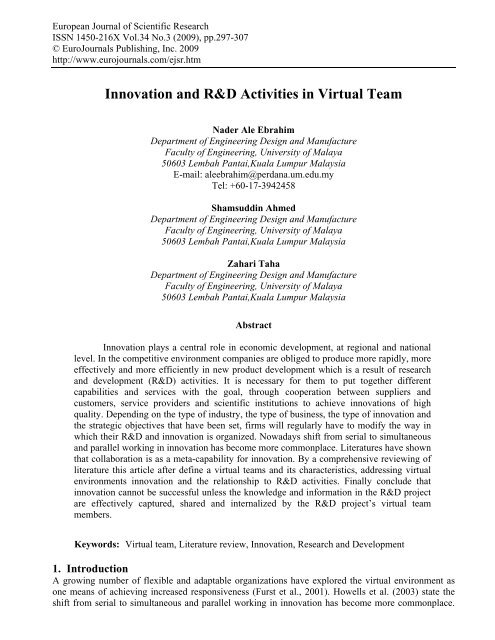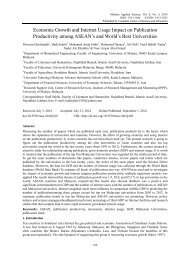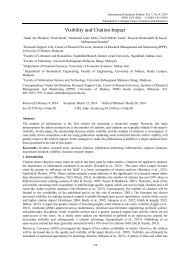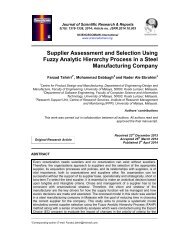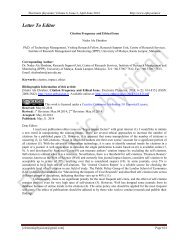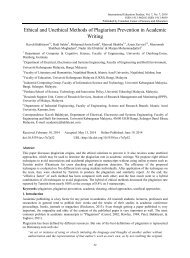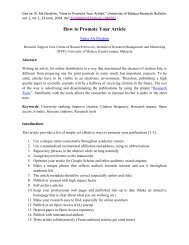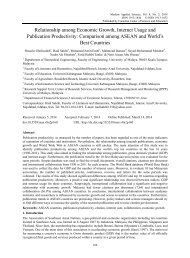Innovation and R&D Activities in Virtual Team
Create successful ePaper yourself
Turn your PDF publications into a flip-book with our unique Google optimized e-Paper software.
European Journal of Scientific Research<br />
ISSN 1450-216X Vol.34 No.3 (2009), pp.297-307<br />
© EuroJournals Publish<strong>in</strong>g, Inc. 2009<br />
http://www.eurojournals.com/ejsr.htm<br />
<strong>Innovation</strong> <strong>and</strong> R&D <strong>Activities</strong> <strong>in</strong> <strong>Virtual</strong> <strong>Team</strong><br />
Nader Ale Ebrahim<br />
Department of Eng<strong>in</strong>eer<strong>in</strong>g Design <strong>and</strong> Manufacture<br />
Faculty of Eng<strong>in</strong>eer<strong>in</strong>g, University of Malaya<br />
50603 Lembah Pantai,Kuala Lumpur Malaysia<br />
E-mail: aleebrahim@perdana.um.edu.my<br />
Tel: +60-17-3942458<br />
Shamsudd<strong>in</strong> Ahmed<br />
Department of Eng<strong>in</strong>eer<strong>in</strong>g Design <strong>and</strong> Manufacture<br />
Faculty of Eng<strong>in</strong>eer<strong>in</strong>g, University of Malaya<br />
50603 Lembah Pantai,Kuala Lumpur Malaysia<br />
Zahari Taha<br />
Department of Eng<strong>in</strong>eer<strong>in</strong>g Design <strong>and</strong> Manufacture<br />
Faculty of Eng<strong>in</strong>eer<strong>in</strong>g, University of Malaya<br />
50603 Lembah Pantai,Kuala Lumpur Malaysia<br />
Abstract<br />
<strong>Innovation</strong> plays a central role <strong>in</strong> economic development, at regional <strong>and</strong> national<br />
level. In the competitive environment companies are obliged to produce more rapidly, more<br />
effectively <strong>and</strong> more efficiently <strong>in</strong> new product development which is a result of research<br />
<strong>and</strong> development (R&D) activities. It is necessary for them to put together different<br />
capabilities <strong>and</strong> services with the goal, through cooperation between suppliers <strong>and</strong><br />
customers, service providers <strong>and</strong> scientific <strong>in</strong>stitutions to achieve <strong>in</strong>novations of high<br />
quality. Depend<strong>in</strong>g on the type of <strong>in</strong>dustry, the type of bus<strong>in</strong>ess, the type of <strong>in</strong>novation <strong>and</strong><br />
the strategic objectives that have been set, firms will regularly have to modify the way <strong>in</strong><br />
which their R&D <strong>and</strong> <strong>in</strong>novation is organized. Nowadays shift from serial to simultaneous<br />
<strong>and</strong> parallel work<strong>in</strong>g <strong>in</strong> <strong>in</strong>novation has become more commonplace. Literatures have shown<br />
that collaboration is as a meta-capability for <strong>in</strong>novation. By a comprehensive review<strong>in</strong>g of<br />
literature this article after def<strong>in</strong>e a virtual teams <strong>and</strong> its characteristics, address<strong>in</strong>g virtual<br />
environments <strong>in</strong>novation <strong>and</strong> the relationship to R&D activities. F<strong>in</strong>ally conclude that<br />
<strong>in</strong>novation cannot be successful unless the knowledge <strong>and</strong> <strong>in</strong>formation <strong>in</strong> the R&D project<br />
are effectively captured, shared <strong>and</strong> <strong>in</strong>ternalized by the R&D project’s virtual team<br />
members.<br />
Keywords: <strong>Virtual</strong> team, Literature review, <strong>Innovation</strong>, Research <strong>and</strong> Development<br />
1. Introduction<br />
A grow<strong>in</strong>g number of flexible <strong>and</strong> adaptable organizations have explored the virtual environment as<br />
one means of achiev<strong>in</strong>g <strong>in</strong>creased responsiveness (Furst et al., 2001). Howells et al. (2003) state the<br />
shift from serial to simultaneous <strong>and</strong> parallel work<strong>in</strong>g <strong>in</strong> <strong>in</strong>novation has become more commonplace.
<strong>Innovation</strong> <strong>and</strong> R&D <strong>Activities</strong> <strong>in</strong> <strong>Virtual</strong> <strong>Team</strong> 298<br />
Companies put <strong>in</strong>novation at the heart of their competitive strategy. When <strong>in</strong>novation is autonomous,<br />
the decentralized virtual team can manage the development <strong>and</strong> commercialization tasks quite well<br />
(Chesbrough <strong>and</strong> Teece, 2002). Blomqvist et al. (2004) emphasized collaboration is as a metacapability<br />
for <strong>in</strong>novation.<br />
Information technologies offer solutions to typical <strong>in</strong>novation problems, such as creativity<br />
management, new product development, product life cycle management, enabl<strong>in</strong>g organizations to<br />
tackle the daily challenges of <strong>in</strong>novation (McKie, 2004). Based on conventional <strong>in</strong>formation<br />
technologies <strong>and</strong> Internet-based platforms virtual environments may be used to susta<strong>in</strong> <strong>in</strong>novation<br />
through virtual <strong>in</strong>teraction <strong>and</strong> communication. Ozer, M. (2004) study suggested that the Internet’s role<br />
will be more pronounced for <strong>in</strong>novative products compared to less <strong>in</strong>novative products; will be more<br />
highlighted for relational new products compared to transactional new products; <strong>and</strong> will be higher for<br />
new <strong>in</strong>dustrial products compared to new consumer products. With regard to the organization related<br />
factors, the role of the Internet <strong>in</strong> new product success will be more pronounced when companies’<br />
learn<strong>in</strong>g, Internet-related technical <strong>and</strong> market<strong>in</strong>g capabilities, <strong>and</strong> collaborative capabilities are high<br />
compared to when they are low.<br />
This paper provides a comprehensive review on different aspects of virtual teams <strong>and</strong><br />
<strong>in</strong>novation based on authentic <strong>and</strong> reputed publications, after def<strong>in</strong>e <strong>in</strong>novation <strong>and</strong> virtual teams <strong>and</strong><br />
its characteristics, address<strong>in</strong>g virtual environments <strong>in</strong>novation <strong>and</strong> the relationship to R&D activities.<br />
F<strong>in</strong>ally conclude that <strong>in</strong>novation cannot be successful unless the knowledge <strong>and</strong> <strong>in</strong>formation <strong>in</strong> the<br />
R&D project are effectively captured, shared <strong>and</strong> <strong>in</strong>ternalized by the R&D project’s virtual team<br />
members. Do<strong>in</strong>g an extensive literature survey, further studies are recommended. Managerial<br />
implications on those issues are also discussed.<br />
2. <strong>Innovation</strong><br />
<strong>Innovation</strong> has long been recognized as crucial to organizational success <strong>and</strong> as an important field of<br />
research <strong>in</strong>quiry (Huang et al., 2004). <strong>Innovation</strong> plays a central role <strong>in</strong> economic development, at<br />
regional <strong>and</strong> national level (Haga, 2005). <strong>Innovation</strong> is someth<strong>in</strong>g new that was <strong>in</strong>troduced <strong>in</strong> an<br />
environment, i.e., a new product, a new way of realiz<strong>in</strong>g a process, etc. (Sorli et al., 2006). Therefore,<br />
an <strong>in</strong>novation represents the f<strong>in</strong>al stage of a development process, represent<strong>in</strong>g the f<strong>in</strong>al result achieved<br />
<strong>and</strong> implemented successfully. <strong>Innovation</strong> correlated with the performance of firms <strong>and</strong> the new<br />
products <strong>and</strong> process improvements partially account for the higher sales <strong>and</strong> employment growth as<br />
well as the higher profit marg<strong>in</strong>s (Dickson <strong>and</strong> Hadjimanolis, 1998). Product <strong>in</strong>novation is undoubtedly<br />
important (Adams et al., 2006). Depend<strong>in</strong>g on the type of <strong>in</strong>dustry, the type of bus<strong>in</strong>ess, the type of<br />
<strong>in</strong>novation <strong>and</strong> the strategic objectives that have been set, firms will regularly (have to) modify the way<br />
<strong>in</strong> which their R&D <strong>and</strong> <strong>in</strong>novation is organized (Erkena <strong>and</strong> Gils<strong>in</strong>g, 2005). (Dickson <strong>and</strong><br />
Hadjimanolis, 1998) <strong>in</strong> their study conclude that the more <strong>in</strong>novative firms, not only <strong>in</strong> terms of new<br />
products <strong>in</strong>troduced <strong>in</strong> the last 2 years <strong>and</strong> their relative novelty, but also <strong>in</strong> terms of process<br />
<strong>in</strong>novation adopted or locally developed, tend to follow proactive <strong>in</strong>novation strategies, be<strong>in</strong>g first-tomarket<br />
with new products <strong>and</strong> <strong>in</strong>vest<strong>in</strong>g <strong>in</strong> order to solve problems, <strong>in</strong>crease capacity or upgrade<br />
quality of products. Sometimes the production of new products also <strong>in</strong>volves a new production l<strong>in</strong>e.<br />
The proactive firms usually have a wider variety of technology sources than less <strong>in</strong>novative firms.<br />
3. R&D <strong>and</strong> <strong>Innovation</strong><br />
With<strong>in</strong> the R&D literature, a number of recent studies have explored the connection among complexity<br />
of labor, organizational <strong>in</strong>novation <strong>and</strong> productivity <strong>in</strong> R&D (Mote, 2005). In a study von Zedtwitz <strong>and</strong><br />
Gassmann (2002) analysis of 1021 R&D units <strong>and</strong> found that research is concentrated <strong>in</strong> five regions<br />
worldwide, while development is more dispersed globally than research. Firms are becom<strong>in</strong>g more<br />
<strong>in</strong>terdependent upon each other for successful outcomes <strong>in</strong> their technological rout<strong>in</strong>g. By be<strong>in</strong>g a<br />
member of an <strong>in</strong>novation network <strong>in</strong> one sense can be said to lower the risks of technological failure,
299 Nader Ale Ebrahim, Shamsudd<strong>in</strong> Ahmed <strong>and</strong> Zahari Taha<br />
as the burden for exploit<strong>in</strong>g the new technology is no longer borne by one firm (Howells et al., 2003).<br />
Precup et al. (2006) conclude that project <strong>in</strong>novation cannot be successful unless the knowledge <strong>and</strong><br />
<strong>in</strong>formation <strong>in</strong> the project are effectively captured, shared <strong>and</strong> <strong>in</strong>ternalized by the project’s virtual team<br />
members. Nordic countries (F<strong>in</strong>l<strong>and</strong>, Sweden, Denmark <strong>and</strong> Norway) are very active <strong>in</strong> <strong>in</strong>novation<br />
cooperation (Arranz <strong>and</strong> Arroyabe, 2008) on the other h<strong>and</strong>, firms <strong>in</strong> countries such as Ch<strong>in</strong>a, Taiwan<br />
<strong>and</strong> South Korea are pay<strong>in</strong>g more attention to design<strong>in</strong>g <strong>and</strong> <strong>in</strong>troduc<strong>in</strong>g new products to global<br />
markets (Perks <strong>and</strong> Wong, 2003). Partners take part <strong>in</strong> R&D networks seek<strong>in</strong>g to ga<strong>in</strong> access to<br />
technological resources <strong>and</strong> to improve their competitive position (Arranz <strong>and</strong> Arroyabe, 2008). For<br />
<strong>in</strong>stance Spanish firms seek to overcome market <strong>and</strong> technological risks through collaboration with<br />
suppliers <strong>and</strong> customers (Arranz <strong>and</strong> Arroyabe, 2008).<br />
4. <strong>Virtual</strong> <strong>Team</strong> Def<strong>in</strong>ition<br />
This era is grow<strong>in</strong>g popularity for virtual team structures <strong>in</strong> organizations (Walvoord et al., 2008,<br />
Cascio, 2000). Mart<strong>in</strong>s et al. (2004) <strong>in</strong> a major review of the literature on virtual teams, conclude that<br />
‘with rare exceptions all organizational teams are virtual to some extent.’ We have moved away from<br />
work<strong>in</strong>g with people who are <strong>in</strong> our visual proximity to work<strong>in</strong>g with people around the globe<br />
(Johnson et al., 2001). Although virtual teamwork is a current topic <strong>in</strong> the literature on global<br />
organizations, it has been problematic to def<strong>in</strong>e what ‘virtual’ means across multiple <strong>in</strong>stitutional<br />
contexts (Chudoba et al., 2005). It is worth mention<strong>in</strong>g that virtual teams are often formed to overcome<br />
geographical or temporal separations (Cascio <strong>and</strong> Shurygailo, 2003). <strong>Virtual</strong> teams work across<br />
boundaries of time <strong>and</strong> space by utiliz<strong>in</strong>g modern computer-driven technologies. The term “virtual<br />
team” is used to cover a wide range of activities <strong>and</strong> forms of technology-supported work<strong>in</strong>g<br />
(Anderson et al., 2007). <strong>Virtual</strong> teams are comprised of members who are located <strong>in</strong> more than one<br />
physical location. This team trait has fostered extensive use of a variety of forms of computer-mediated<br />
communication that enable geographically dispersed members to coord<strong>in</strong>ate their <strong>in</strong>dividual efforts <strong>and</strong><br />
<strong>in</strong>puts (Peters <strong>and</strong> Manz, 2007). From the perspective of Leenders et al.(Leenders et al., 2003) virtual<br />
teams are groups of <strong>in</strong>dividuals collaborat<strong>in</strong>g <strong>in</strong> the execution of a specific project while<br />
geographically <strong>and</strong> often temporally distributed, possibly anywhere with<strong>in</strong> (<strong>and</strong> beyond) their parent<br />
organization. Amongst the different def<strong>in</strong>itions of the concept of a virtual team the follow<strong>in</strong>g from is<br />
one of the most widely accepted: (Powell et al., 2004), ‘‘virtual teams as groups of geographically,<br />
organizationally <strong>and</strong>/or time dispersed workers brought together by <strong>in</strong>formation technologies to<br />
accomplish one or more organization tasks’’. The degree of geographic dispersion with<strong>in</strong> a virtual<br />
team can vary widely from hav<strong>in</strong>g one member located <strong>in</strong> a different location than the rest of the team<br />
to hav<strong>in</strong>g each member located <strong>in</strong> a different country (Staples <strong>and</strong> Zhao, 2006).<br />
4.1. <strong>Virtual</strong> <strong>Team</strong> Characteristics<br />
Along with Bal <strong>and</strong> Teo (2001) f<strong>in</strong>d<strong>in</strong>g, it could be concluded that a team will become virtual if it<br />
meets four ma<strong>in</strong> common criteria <strong>and</strong> other characteristics that are summarized <strong>in</strong> Table 1.<br />
Geographically dispersed teams allow organizations to hire <strong>and</strong> reta<strong>in</strong> the best people regardless of<br />
location. The temporary aspect of the team appears less emphasized (Lee-Kelley <strong>and</strong> Sankey, 2008)<br />
although (Bal <strong>and</strong> Teo, 2001, Paul et al., 2005, Wong <strong>and</strong> Burton, 2000) <strong>in</strong>cluded temporary <strong>in</strong> virtual<br />
team def<strong>in</strong>ition but some authors like Gassmann <strong>and</strong> Von Zedtwitz (2003) use may be temporary for<br />
some team members.<br />
5. Benefits <strong>and</strong> Drawbacks of <strong>Virtual</strong> <strong>Team</strong>s<br />
The availability of a flexible <strong>and</strong> configurable base <strong>in</strong>frastructure is one of the ma<strong>in</strong> advantages of agile<br />
virtual teams. (Anderson et al., 2007). <strong>Virtual</strong> R&D teams which members do not work at the same<br />
time or place (Stoker et al., 2001) often face tight schedules <strong>and</strong> a need to start quickly <strong>and</strong> perform
<strong>Innovation</strong> <strong>and</strong> R&D <strong>Activities</strong> <strong>in</strong> <strong>Virtual</strong> <strong>Team</strong> 300<br />
<strong>in</strong>stantly (Munkvold <strong>and</strong> Zigurs, 2007). On the other h<strong>and</strong>, virtual teams reduce time-to-market (May<br />
<strong>and</strong> Carter, 2001). Lead Time or Time to market has been generally admitted to be one of the most<br />
important keys for success <strong>in</strong> manufactur<strong>in</strong>g companies (Sorli et al., 2006). Table 2 summarizes some<br />
of the ma<strong>in</strong> advantages <strong>and</strong> Table 3 some of the ma<strong>in</strong> disadvantages associated with virtual team<strong>in</strong>g.<br />
Table 1:<br />
common criteria of virtual team<br />
Characteristics<br />
of virtual team<br />
Common<br />
criteria<br />
Other<br />
characteristics<br />
Descriptions<br />
1. Geographically dispersed (over different<br />
time zones)<br />
References<br />
(Dafoulas <strong>and</strong> Macaulay, 2002, Sh<strong>in</strong>, 2005, Wong<br />
<strong>and</strong> Burton, 2000, Nemiro, 2002, Peters <strong>and</strong> Manz,<br />
2007, Lee-Kelley <strong>and</strong> Sankey, 2008)<br />
(Bal <strong>and</strong> Teo, 2001, Sh<strong>in</strong>, 2005, Hertel et al., 2005,<br />
Gassmann <strong>and</strong> Von Zedtwitz, 2003, Rezgui, 2007)<br />
2. Driven by common purpose (guided by a<br />
common purpose)<br />
3. Enabled by communication technologies (Bal <strong>and</strong> Teo, 2001, Nemiro, 2002, Peters <strong>and</strong> Manz,<br />
2007, Lee-Kelley <strong>and</strong> Sankey, 2008)<br />
4. Involved <strong>in</strong> cross-boundary collaboration (Bal <strong>and</strong> Teo, 2001, Gassmann <strong>and</strong> Von Zedtwitz,<br />
2003, Rezgui, 2007, Precup et al., 2006)<br />
1. It is not a permanent team (Bal <strong>and</strong> Teo, 2001, Paul et al., 2005, Wong <strong>and</strong><br />
Burton, 2000)<br />
2. Small team size (Bal <strong>and</strong> Teo, 2001)<br />
3. <strong>Team</strong> member are knowledge workers (Bal <strong>and</strong> Teo, 2001, Kirkman et al., 2004)<br />
4. <strong>Team</strong> members may belong to different<br />
companies<br />
(Dafoulas <strong>and</strong> Macaulay, 2002)
301 Nader Ale Ebrahim, Shamsudd<strong>in</strong> Ahmed <strong>and</strong> Zahari Taha<br />
Table 2:<br />
some of the ma<strong>in</strong> advantages associated with virtual team<strong>in</strong>g.<br />
Advantages<br />
References<br />
Reduc<strong>in</strong>g relocation time <strong>and</strong> costs, reduced travel costs (McDonough et al., 2001, Rice et al., 2007, Bergiel et al.,<br />
2008, Cascio, 2000, Fuller et al., 2006, Kankanhalli et al.,<br />
2006)<br />
Reduc<strong>in</strong>g time-to-market [Time also has an almost 1:1<br />
correlation with cost, so cost will likewise be reduced if the<br />
time-to market is quicker (Rabelo <strong>and</strong> Jr., 2005)]<br />
(May <strong>and</strong> Carter, 2001, Sorli et al., 2006, Kankanhalli et<br />
al., 2006, Chen, 2008, Shachaf, 2008, Kusar et al., 2004,<br />
Ge <strong>and</strong> Hu, 2008, Mulebeke <strong>and</strong> Zheng, 2006)<br />
More effective R&D cont<strong>in</strong>uation decisions (Cumm<strong>in</strong>gs <strong>and</strong> Teng, 2003)<br />
Able to tap selectively <strong>in</strong>to center of excellence, us<strong>in</strong>g the<br />
best talent regardless of location<br />
(Criscuolo, 2005, Cascio, 2000, Samarah et al., 2007,<br />
Fuller et al., 2006)<br />
Greater productivity, shorter development times (McDonough et al., 2001, Mulebeke <strong>and</strong> Zheng, 2006)<br />
Greater degree of freedom to <strong>in</strong>dividuals <strong>in</strong>volved with the (Ojasalo, 2008)<br />
development project<br />
Higher degree of cohesion (<strong>Team</strong>s can be organized (Kratzer et al., 2005, Cascio, 2000, Gaudes et al., 2007)<br />
whether or not members are <strong>in</strong> proximity to one another)<br />
Produc<strong>in</strong>g better outcomes <strong>and</strong> attract better employees (Mart<strong>in</strong>s et al., 2004, Rice et al., 2007)<br />
Provide organizations with unprecedented level of (Powell et al., 2004, Hunsaker <strong>and</strong> Hunsaker, 2008, Chen,<br />
flexibility <strong>and</strong> responsiveness<br />
2008, Katzy et al., 2000)<br />
Can manage the development <strong>and</strong> commercialization tasks (Chesbrough <strong>and</strong> Teece, 2002)<br />
quite well<br />
Organizations seek<strong>in</strong>g to leverage scarce resources across (Munkvold <strong>and</strong> Zigurs, 2007)<br />
geographic <strong>and</strong> other boundaries<br />
Respond quickly to chang<strong>in</strong>g bus<strong>in</strong>ess environments (Bergiel et al., 2008, Mulebeke <strong>and</strong> Zheng, 2006)<br />
Shar<strong>in</strong>g knowledge, experiences (Rosen et al., 2007, Zakaria et al., 2004)<br />
Enable organizations to respond faster to <strong>in</strong>creased (Hunsaker <strong>and</strong> Hunsaker, 2008, Pauleen, 2003)<br />
competition<br />
Better team outcomes (quality, productivity, <strong>and</strong> (Gaudes et al., 2007, Ortiz de Gu<strong>in</strong>ea et al., 2005)<br />
satisfaction)<br />
Most effective <strong>in</strong> mak<strong>in</strong>g decisions (Hossa<strong>in</strong> <strong>and</strong> Wig<strong>and</strong>, 2004)<br />
Higher team effectiveness <strong>and</strong> efficiency (May <strong>and</strong> Carter, 2001, Shachaf <strong>and</strong> Hara, 2005)<br />
Self-assessed performance <strong>and</strong> high performance. (Chudoba et al., 2005, Poehler <strong>and</strong> Schumacher, 2007)<br />
Cultivat<strong>in</strong>g <strong>and</strong> manag<strong>in</strong>g creativity (Leenders et al., 2003)<br />
Improve the detail <strong>and</strong> precision of design activities (Vaccaro et al., 2008)<br />
Provide a vehicle for global collaboration <strong>and</strong> coord<strong>in</strong>ation (Paul et al., 2005 )<br />
of R&D-related activities<br />
Table 3:<br />
some of the ma<strong>in</strong> disadvantages associated with virtual team<strong>in</strong>g.<br />
Disadvantages<br />
References<br />
lack of physical <strong>in</strong>teraction<br />
(Cascio, 2000, Hossa<strong>in</strong> <strong>and</strong> Wig<strong>and</strong>, 2004, Kankanhalli et<br />
al., 2006, Rice et al., 2007)<br />
everyth<strong>in</strong>g to be re<strong>in</strong>forced <strong>in</strong> a much more structured, (Lurey <strong>and</strong> Rais<strong>in</strong>ghani, 2001).<br />
formal process<br />
Challenges of project management are more related to the (Mart<strong>in</strong>ez-Sanchez et al., 2006).<br />
distance between team members than to their cultural or<br />
language differences<br />
Challenges of determ<strong>in</strong><strong>in</strong>g the appropriate task technology (Qureshi <strong>and</strong> Vogel, 2001, Ocker <strong>and</strong> Fjermestad, 2008)<br />
fit<br />
Cultural <strong>and</strong> functional diversity <strong>in</strong> virtual teams lead to (Paul et al., 2005 , Poehler <strong>and</strong> Schumacher, 2007,<br />
differences <strong>in</strong> the members’ thought processes. Develop Kankanhalli et al., 2006)<br />
trust among the members are challeng<strong>in</strong>g<br />
Will create challenges <strong>and</strong> obstacles like technophobia ( (Johnson et al., 2001)<br />
employees who are uncomfortable with computer <strong>and</strong> other<br />
telecommunications technologies)<br />
Variety of practices (cultural <strong>and</strong> work process diversity) (Chudoba et al., 2005)<br />
<strong>and</strong> employee mobility negatively impacted performance <strong>in</strong><br />
virtual teams.<br />
<strong>Team</strong> members need special tra<strong>in</strong><strong>in</strong>g <strong>and</strong> encouragement (Ryssen <strong>and</strong> Godar, 2000)
<strong>Innovation</strong> <strong>and</strong> R&D <strong>Activities</strong> <strong>in</strong> <strong>Virtual</strong> <strong>Team</strong> 302<br />
6. <strong>Virtual</strong> <strong>and</strong> Traditional R&D <strong>Team</strong>s<br />
Unlike a traditional team, a virtual team works across space, time <strong>and</strong> organizational boundaries with<br />
l<strong>in</strong>ks strengthened by webs of communication technologies. However, many of the best practices for<br />
traditional teams are similar to those for virtual teams (Bergiel et al., 2008). <strong>Virtual</strong> teams are<br />
significantly different from traditional teams. In the proverbial traditional team, the members work<br />
next to one another, while <strong>in</strong> virtual teams they work <strong>in</strong> different locations. In traditional teams the<br />
coord<strong>in</strong>ation of tasks is straightforward <strong>and</strong> performed by the members of the team together; <strong>in</strong> virtual<br />
teams, <strong>in</strong> contrast, tasks must be much more highly structured. Also, virtual teams rely on electronic<br />
communication, as opposed to face-to-face communication <strong>in</strong> traditional teams. Table 4 summarizes<br />
these dist<strong>in</strong>ctions (Kratzer et al., 2005). Diversity <strong>in</strong> national background <strong>and</strong> culture is common <strong>in</strong><br />
transnational <strong>and</strong> virtual teams (Staples <strong>and</strong> Zhao, 2006).<br />
Table 4:<br />
<strong>Virtual</strong> <strong>and</strong> traditional R&D teams are usually viewed as opposites.<br />
Fully Traditional <strong>Team</strong><br />
<strong>Team</strong> members all co-located.<br />
<strong>Team</strong> members communicate face-to-face (i.e.,<br />
synchronous <strong>and</strong> personal)<br />
<strong>Team</strong> members coord<strong>in</strong>ate team task together, <strong>in</strong> mutual<br />
adjustment.<br />
Fully <strong>Virtual</strong> <strong>Team</strong><br />
<strong>Team</strong> members all <strong>in</strong> different locations.<br />
<strong>Team</strong> members communicate through asynchronous <strong>and</strong><br />
impersonal means.<br />
The team task is so highly structured that coord<strong>in</strong>ation by<br />
team members is rarely necessary.<br />
In particular, reliance on computer-mediated communication makes virtual teams unique from<br />
traditional ones (Munkvold <strong>and</strong> Zigurs, 2007). Kratzer et al.(2005) research shows that traditional<br />
R&D teams have become rare. The processes used by successful virtual teams will be different from<br />
those used <strong>in</strong> face-to-face collaborations (FFCs) (Rice et al., 2007). In an <strong>in</strong>novation network<br />
resembl<strong>in</strong>g a “traditional” organization, the <strong>in</strong>novation process is more restricted by location <strong>and</strong> time.<br />
In other words, the <strong>in</strong>novation process mostly takes place with<strong>in</strong> the framework of physical offices <strong>and</strong><br />
work<strong>in</strong>g hours. In virtual organizations, <strong>in</strong>dividuals’ work is not restricted by time <strong>and</strong> place, <strong>and</strong><br />
communication is strongly facilitated by IT. Such a product development environment allows a greater<br />
degree of freedom to <strong>in</strong>dividuals <strong>in</strong>volved with the development project (Ojasalo, 2008). Hence<br />
mult<strong>in</strong>ational companies (MNC) are more likely to become tightly <strong>in</strong>tegrated <strong>in</strong>to global R&D network<br />
than smaller unit (Boehe, 2007). Distributed teams can carry out critical tasks with appropriate decision<br />
support technologies (Chen et al., 2007).<br />
7. Physical vs. <strong>Virtual</strong><br />
Pawar <strong>and</strong> Sharifi (Pawar <strong>and</strong> Sharifi, 1997) study of virtual versus collocated team success <strong>and</strong><br />
classified physical teams versus virtual teams <strong>in</strong> six categories.<br />
Table 5 summarizes these differences.<br />
Lurey <strong>and</strong> Rais<strong>in</strong>ghani (2001) base on virtual teams survey <strong>in</strong> 12 separate virtual teams from<br />
eight different sponsor companies <strong>in</strong> the high technology found that, organizations choos<strong>in</strong>g to<br />
implement virtual teams should focus much of their efforts <strong>in</strong> the same direction they would if they<br />
were implement<strong>in</strong>g traditional, co-located teams.
303 Nader Ale Ebrahim, Shamsudd<strong>in</strong> Ahmed <strong>and</strong> Zahari Taha<br />
Table 5:<br />
Classify<strong>in</strong>g physical teams versus virtual teams<br />
Activity Physical teams nature <strong>Virtual</strong> teams nature<br />
Nature of <strong>in</strong>teraction<br />
opportunity to share work <strong>and</strong> nonwork<br />
related <strong>in</strong>formation<br />
the extent of <strong>in</strong>formal exchange of<br />
<strong>in</strong>formation is m<strong>in</strong>imal<br />
Utilization of resources Increases the opportunity for each collaborat<strong>in</strong>g body will have to<br />
allocation <strong>and</strong> shar<strong>in</strong>g of resources have access to similar technical <strong>and</strong><br />
Control <strong>and</strong> accountability (over <strong>and</strong><br />
with<strong>in</strong> the project):<br />
Work<strong>in</strong>g environment<br />
Cultural <strong>and</strong> educational background<br />
Technological compatibility:<br />
Project manager provides the context<br />
for ongo<strong>in</strong>g monitor<strong>in</strong>g of activities<br />
<strong>and</strong> events <strong>and</strong> thus enhances their<br />
ability to respond to requirements.<br />
they encountered constra<strong>in</strong>ts access<strong>in</strong>g<br />
<strong>in</strong>formation <strong>and</strong> <strong>in</strong>teract<strong>in</strong>g with<br />
others outside the collocated team<br />
with<strong>in</strong> the company<br />
members of the team are likely to<br />
have similar <strong>and</strong> complementary<br />
cultural <strong>and</strong> educational background<br />
situated <strong>and</strong> operat<strong>in</strong>g with<strong>in</strong> a s<strong>in</strong>gle<br />
organization, faces m<strong>in</strong>imal<br />
<strong>in</strong>compatibility of the technological<br />
systems<br />
non-technical <strong>in</strong>frastructure<br />
The collaborat<strong>in</strong>g bodies were<br />
accountable to the task leaders <strong>and</strong> the<br />
project coord<strong>in</strong>ator who had limited<br />
authority to enforce any penalties for<br />
failure to achieve their tasks<br />
Sometimes not able to share ideas or<br />
dilemmas with other partners.<br />
the team members varied <strong>in</strong> their<br />
education, culture, language, time<br />
orientation <strong>and</strong> expertise<br />
compatibility between different<br />
systems <strong>in</strong> collaborat<strong>in</strong>g organizations<br />
ought to be negotiated at the outset<br />
8. Conclusion<br />
Products are be<strong>in</strong>g witnessed every day ga<strong>in</strong><strong>in</strong>g the knowhow <strong>and</strong> the right knowledge for keep<strong>in</strong>g<br />
pace with the rate <strong>and</strong> <strong>in</strong>tensity of change has become an <strong>in</strong>evitable necessity. <strong>Virtual</strong> teams provide an<br />
environment for flourish<strong>in</strong>g <strong>in</strong>novation <strong>in</strong> R&D <strong>and</strong> br<strong>in</strong>g about knowledge spillovers with<strong>in</strong><br />
enterprises bridg<strong>in</strong>g time <strong>and</strong> place, therefore the decision on sett<strong>in</strong>g up virtual teams <strong>in</strong> R&D is not a<br />
choice but a requirement. The globalization of <strong>and</strong> the new waves of global trends <strong>in</strong> economy,<br />
services <strong>and</strong> bus<strong>in</strong>ess along with advances <strong>in</strong> telecommunications technology have paved the way for<br />
the formation <strong>and</strong> the performance of virtual teams. While review<strong>in</strong>g the previous study refer to Table<br />
2 <strong>and</strong> Table 3, it’s believed that the advantages of work<strong>in</strong>g on the basis of virtual teams far outweigh<br />
the disadvantages <strong>and</strong> <strong>in</strong>novation cannot be successful unless the knowledge <strong>and</strong> <strong>in</strong>formation <strong>in</strong> the<br />
R&D project are effectively captured, shared <strong>and</strong> <strong>in</strong>ternalized by the R&D project’s virtual team<br />
members.<br />
This paper has provided an extensive review of literature <strong>and</strong> related resources cover<strong>in</strong>g the<br />
theme of virtual R&D teams <strong>and</strong> <strong>in</strong>novation. Clearly there is a considerable scope for extend<strong>in</strong>g this<br />
study to specify filed such as small <strong>and</strong> medium enterprises (SMEs) <strong>and</strong> relationship with virtual R&D<br />
team. Further research has to be done on this topic to fully underst<strong>and</strong> the <strong>in</strong>fluence of virtual R&D<br />
team on <strong>in</strong>novation practically. The review shows that whereas a considerable number of studies <strong>and</strong><br />
research efforts have been conducted <strong>and</strong> concentrated on <strong>in</strong>novation or virtual R&D teams, limited<br />
work have been directed towards explor<strong>in</strong>g <strong>and</strong> analyz<strong>in</strong>g the exist<strong>in</strong>g <strong>in</strong>ter-relation. Therefore future<br />
research shall be aimed at shift<strong>in</strong>g away from <strong>in</strong>vestigat<strong>in</strong>g <strong>in</strong>novation <strong>and</strong> virtual R&D teams<br />
separately to the formation <strong>and</strong> development of a collaborative system which can support a dispersed<br />
team effectively. Keep<strong>in</strong>g virtual R&D teams <strong>in</strong> <strong>in</strong>novation processes, operat<strong>in</strong>g <strong>in</strong>novatively,<br />
effectively <strong>and</strong> efficiently is of a high importance, but the issue has poorly been addressed<br />
simultaneously <strong>in</strong> the previous studies.
<strong>Innovation</strong> <strong>and</strong> R&D <strong>Activities</strong> <strong>in</strong> <strong>Virtual</strong> <strong>Team</strong> 304<br />
References<br />
[1] ADAMS, R., BESSANT, J. & PHELPS, R. (2006) <strong>Innovation</strong> Management Measurement: A<br />
Review. International Journal of Management Reviews, 8, 21-47.<br />
[2] ANDERSON, A. H., MCEWAN, R., BAL, J. & CARLETTA, J. (2007) <strong>Virtual</strong> team meet<strong>in</strong>gs:<br />
An analysis of communication <strong>and</strong> context. Computers <strong>in</strong> Human Behavior, 23, 2558–2580.<br />
[3] ARRANZ, N. & ARROYABE, J. C. F. D. (2008) The choice of partners <strong>in</strong> R&D cooperation:<br />
An empirical analysis of Spanish firms. Technovation, 28, 88–100.<br />
[4] BAL, J. & TEO, P. K. (2001) Implement<strong>in</strong>g virtual teamwork<strong>in</strong>g. Part 1: a literature review of<br />
best practice. Logistics Information Management, 13, 346 - 352.<br />
[5] BERGIEL, J. B., BERGIEL, E. B. & BALSMEIER, P. W. (2008) Nature of virtual teams: a<br />
summary of their advantages <strong>and</strong> disadvantages. Management Research News, 31, 99-110.<br />
[6] BLOMQVIST, K., HARA, V., KOIVUNIEMI, J. & ÄIJö, T. (2004) Towards networked R&D<br />
management: the R&D approach of Sonera Corporation as an example. R&D Management, 34,<br />
591-603.<br />
[7] BOEHE, D. M. (2007) Product development <strong>in</strong> MNC subsidiaries: Local l<strong>in</strong>kages <strong>and</strong> global<br />
<strong>in</strong>terdependencies. Journal of International Management, 13, 488–512.<br />
[8] CASCIO, W. F. (2000) Manag<strong>in</strong>g a virtual workplace. The Academy of Management Executive,<br />
14, 81-90.<br />
[9] CASCIO, W. F. & SHURYGAILO, S. (2003) E-Leadership <strong>and</strong> <strong>Virtual</strong> <strong>Team</strong>s. Organizational<br />
Dynamics, 31, 362-376.<br />
[10] CHEN, M., LIOU, Y., WANG, C. W., FAN, Y. W. & CHI, Y. P. J. (2007) <strong>Team</strong> Spirit:<br />
Design, implementation, <strong>and</strong> evaluation of a Web-based group decision support system.<br />
Decision Support Systems, 43, 1186–1202.<br />
[11] CHEN, T.-Y. (2008) Knowledge shar<strong>in</strong>g <strong>in</strong> virtual enterprises via an ontology-based access<br />
control approach. Computers <strong>in</strong> Industry, Article In press, No of Pages 18.<br />
[12] CHESBROUGH, H. W. & TEECE, D. J. (2002) Organiz<strong>in</strong>g for <strong>Innovation</strong>: When Is <strong>Virtual</strong><br />
Virtuous? Harvard Bus<strong>in</strong>ess Review Article, August 127-135.<br />
[13] CHUDOBA, K. M., WYNN, E., LU, M., WATSON-MANHEIM & BETH, M. (2005) How<br />
virtual are we? Measur<strong>in</strong>g virtuality <strong>and</strong> underst<strong>and</strong><strong>in</strong>g its impact <strong>in</strong> a global organization.<br />
Information Systems Journal, 15, 279-306.<br />
[14] CRISCUOLO, P. (2005) On the road aga<strong>in</strong>: Researcher mobility <strong>in</strong>side the R&D network.<br />
Research Policy, 34, 1350–1365<br />
[15] CUMMINGS, J. L. & TENG, B. S. (2003) Transferr<strong>in</strong>g R&D knowledge: the key factors<br />
affect<strong>in</strong>g knowledge transfer success. Journal of Eng<strong>in</strong>eer<strong>in</strong>g Technology Management, 39–68.<br />
[16] DAFOULAS, G. & MACAULAY, L. (2002) Investigat<strong>in</strong>g Cultural Differences <strong>in</strong> <strong>Virtual</strong><br />
Software <strong>Team</strong>s. The Electronic Journal of Information Systems <strong>in</strong> Develop<strong>in</strong>g Countries<br />
(EJISDC), 7, 1-14.<br />
[17] DICKSON, K. E. & HADJIMANOLIS, A. (1998) <strong>Innovation</strong> <strong>and</strong> network<strong>in</strong>g amongst small<br />
manufactur<strong>in</strong>g firms <strong>in</strong> Cyprus. International Journal of Entrepreneurial Behavior & Research,<br />
4, 5-17.<br />
[18] ERKENA, H. & GILSING, V. (2005) Relocation of R&D - a Dutch perspective. Technovation,<br />
25, 1079–1092.<br />
[19] FULLER, M. A., HARDIN, A. M. & DAVISON, R. M. (2006) Efficacy <strong>in</strong> Technology-<br />
Mediated Distributed <strong>Team</strong> Journal of Management Information Systems, 23, 209-235.<br />
[20] FURST, S., BLACKBURN, R. & ROSEN, B. (2001) <strong>Virtual</strong> team effectiveness: a proposed<br />
research agenda. Information Systems Journal, 9, 249 - 269.<br />
[21] GASSMANN, O. & VON ZEDTWITZ, M. (2003) Trends <strong>and</strong> determ<strong>in</strong>ants of manag<strong>in</strong>g<br />
virtual R&D teams. R&D Management 33, 243-262.<br />
[22] GAUDES, A., HAMILTON-BOGART, B., MARSH, S. & ROBINSON, H. (2007) A<br />
Framework for Construct<strong>in</strong>g Effective <strong>Virtual</strong> <strong>Team</strong>s The Journal of E-work<strong>in</strong>g 1, 83-97
305 Nader Ale Ebrahim, Shamsudd<strong>in</strong> Ahmed <strong>and</strong> Zahari Taha<br />
[23] GE, Z. & HU, Q. (2008) Collaboration <strong>in</strong> R&D activities: Firm-specific decisions. European<br />
Journal of Operational Research 185, 864-883.<br />
[24] HAGA, T. (2005) Action research <strong>and</strong> <strong>in</strong>novation <strong>in</strong> networks, dilemmas <strong>and</strong> challenges: two<br />
cases AI & Society 19, 362-383.<br />
[25] HERTEL, G. T., GEISTER, S. & KONRADT, U. (2005) Manag<strong>in</strong>g virtual teams: A review of<br />
current empirical research. Human Resource Management Review, 15, 69–95.<br />
[26] HOSSAIN, L. & WIGAND, R. T. (2004) ICT Enabled <strong>Virtual</strong> Collaboration through Trust.<br />
Journal of Computer-Mediated Communication, 10.<br />
[27] HOWELLS, J., JAMES, A. & MALIK, K. (2003) The sourc<strong>in</strong>g of technological knowledge:<br />
distributed <strong>in</strong>novation processes <strong>and</strong> dynamic change. R&D Management, 33, 395-409.<br />
[28] HUANG, X., SOUTAR, G. N. & BROWN, A. (2004) Measur<strong>in</strong>g new product success: an<br />
empirical <strong>in</strong>vestigation of Australian SMEs. Industrial Market<strong>in</strong>g Management, 33, 117– 123.<br />
[29] HUNSAKER, P. L. & HUNSAKER, J. S. (2008) <strong>Virtual</strong> teams: a leader's guide. <strong>Team</strong><br />
Performance Management, 14, 86-101.<br />
[30] JOHNSON, P., HEIMANN, V. & O’NEILL, K. (2001) The “wonderl<strong>and</strong>” of virtual teams.<br />
Journal of Workplace Learn<strong>in</strong>g, 13, 24 - 30.<br />
[31] KANKANHALLI, A., TAN, B. C. Y. & WEI, K.-K. (2006) Conflict <strong>and</strong> Performance <strong>in</strong><br />
Global <strong>Virtual</strong> <strong>Team</strong>s. Journal of Management Information Systems, 23, 237-274.<br />
[32] KATZY, B., EVARISTO, R. & ZIGURS, I. (2000) Knowledge Management <strong>in</strong> <strong>Virtual</strong><br />
Projects: A Research Agenda. Proceed<strong>in</strong>gs of the 33rd Hawaii International Conference on<br />
System Sciences<br />
[33] KIRKMAN, B. L., ROSEN, B., TESLUK, P. E. & GIBSON, C. B. (2004) THE IMPACT OF<br />
TEAM EMPOWERMENT ON VIRTUAL TEAM PERFORMANCE: THE MODERATING<br />
ROLE OF FACE-TO-FACE INTERACTION. Academy of Management Journal, 47, 175-192.<br />
[34] KRATZER, J., LEENDERS, R. & ENGELEN, J. V. (2005) Keep<strong>in</strong>g <strong>Virtual</strong> R&D <strong>Team</strong>s<br />
Creative. Industrial Research Institute, Inc., March-April, 13-16.<br />
[35] KUSAR, J., DUHOVNIK, J., GRUM, J. & STARBEK, M. (2004) How to reduce new product<br />
development time. Robotics <strong>and</strong> Computer-Integrated Manufactur<strong>in</strong>g 20, 1-15.<br />
[36] LEE-KELLEY, L. & SANKEY, T. (2008) Global virtual teams for value creation <strong>and</strong> project<br />
success: A case study. International Journal of Project Management 26, 51–62.<br />
[37] LEENDERS, R. T. A. J., ENGELEN, J. M. L. V. & KRATZER, J. (2003) <strong>Virtual</strong>ity,<br />
communication, <strong>and</strong> new product team creativity: a social network perspective. Journal of<br />
Eng<strong>in</strong>eer<strong>in</strong>g <strong>and</strong> Technology Management, 20, 69–92.<br />
[38] LUREY, J. S. & RAISINGHANI, M. S. (2001) An empirical study of best practices <strong>in</strong> virtual<br />
teams Information & Management, 38, 523-544.<br />
[39] MARTINEZ-SANCHEZ, A., PEREZ-PEREZ, M., DE-LUIS-CARNICER, P. & VELA-<br />
JIMENEZ, M. J. (2006) Telework<strong>in</strong>g <strong>and</strong> new product development. European Journal of<br />
<strong>Innovation</strong> Management, 9, 202-214.<br />
[40] MARTINS, L. L., GILSON, L. L. & MAYNARD, M. T. (2004) <strong>Virtual</strong> teams: What do we<br />
know <strong>and</strong> where do we go from here? Journal of Management, 30, 805–835.<br />
[41] MAY, A. & CARTER, C. (2001) A case study of virtual team work<strong>in</strong>g <strong>in</strong> the European<br />
automotive <strong>in</strong>dustry. International Journal of Industrial Ergonomics, 27, 171-186.<br />
[42] MCDONOUGH, E. F., KAHN, K. B. & BARCZAK, G. (2001) An <strong>in</strong>vestigation of the use of<br />
global, virtual, <strong>and</strong> collocated new product development teams. The Journal of Product<br />
<strong>Innovation</strong> Management, 18, 110–120.<br />
[43] MCKIE, S. (2004) <strong>Innovation</strong> Management Technology - Disruptive <strong>in</strong>novation on the way?<br />
[44] MOTE, J. E. (2005) R&D ecology: us<strong>in</strong>g 2-mode network analysis to explore complexity <strong>in</strong><br />
R&D environments. Journal of Eng<strong>in</strong>eer<strong>in</strong>g <strong>and</strong> Technology Management, 22, 93-111.<br />
[45] MULEBEKE, J. A. W. & ZHENG, L. (2006) Incorporat<strong>in</strong>g <strong>in</strong>tegrated product development<br />
with technology road mapp<strong>in</strong>g for dynamism <strong>and</strong> <strong>in</strong>novation. International Journal of Product<br />
Development 3, 56 - 76.
<strong>Innovation</strong> <strong>and</strong> R&D <strong>Activities</strong> <strong>in</strong> <strong>Virtual</strong> <strong>Team</strong> 306<br />
[46] MUNKVOLD, B. E. & ZIGURS, I. (2007) Process <strong>and</strong> technology challenges <strong>in</strong> swift-start<strong>in</strong>g<br />
virtual teams. Information & Management, 44, 287–299.<br />
[47] NEMIRO, J. E. (2002) The Creative Process <strong>in</strong> <strong>Virtual</strong> <strong>Team</strong>s Creativity Research Journal, 14,<br />
69 - 83.<br />
[48] OCKER, R. J. & FJERMESTAD, J. (2008) Communication differences <strong>in</strong> virtual design teams:<br />
f<strong>in</strong>d<strong>in</strong>gs from a multi-method analysis of high <strong>and</strong> low perform<strong>in</strong>g experimental teams. The<br />
DATA BASE for Advances <strong>in</strong> Information Systems, 39, 51-67.<br />
[49] OJASALO, J. (2008) Management of <strong>in</strong>novation networks: a case study of different<br />
approaches. European Journal of <strong>Innovation</strong> Management, 11, 51-86.<br />
[50] ORTIZ DE GUINEA, A., WEBSTER, J. & STAPLES, S. (2005) A Meta-Analysis of the<br />
<strong>Virtual</strong> <strong>Team</strong>s Literature. Symposium on High Performance Professional <strong>Team</strong>s Industrial<br />
Relations Centre. School of Policy Studies, Queen’s University, K<strong>in</strong>gston, Canada.<br />
[51] OZER, M. (2004) The role of the Internet <strong>in</strong> new product performance: A conceptual<br />
<strong>in</strong>vestigation. Industrial Market<strong>in</strong>g Management 33, 355– 369.<br />
[52] PAUL, S., SEETHARAMAN, P., SAMARAH, I. & PETER MYKYTYN, J. (2005)<br />
Underst<strong>and</strong><strong>in</strong>g Conflict <strong>in</strong> <strong>Virtual</strong> <strong>Team</strong>s: An Experimental Investigation us<strong>in</strong>g Content<br />
Analysis. 38th Hawaii International Conference on System Sciences. Hawaii.<br />
[53] PAUL, S., SEETHARAMAN, P., SAMARAH, I. & PETER MYKYTYN, J. (2005)<br />
Underst<strong>and</strong><strong>in</strong>g Conflict <strong>in</strong> <strong>Virtual</strong> <strong>Team</strong>s: An Experimental Investigation us<strong>in</strong>g Content<br />
Analysis. 38th Hawaii International Conference on System Sciences. Hawaii.<br />
[54] PAULEEN, D. J. (2003) An Inductively Derived Model of Leader-Initiated Relationship<br />
Build<strong>in</strong>g with <strong>Virtual</strong> <strong>Team</strong> Members. Journal of Management Information Systems, 20, 227-<br />
256.<br />
[55] PAWAR, K. S. & SHARIFI, S. (1997) Physical or virtual team collocation: Does it matter?<br />
International Journal of Production Economics 52, 283-290.<br />
[56] PERKS, H. & WONG, V. (2003) research <strong>in</strong> <strong>in</strong>ternational new product development – current<br />
underst<strong>and</strong><strong>in</strong>g <strong>and</strong> future imperatives. International Market<strong>in</strong>g Review, 20, 344-352.<br />
[57] PETERS, L. M. & MANZ, C. C. (2007) Identify<strong>in</strong>g antecedents of virtual team collaboration.<br />
<strong>Team</strong> Performance Management, 13, 117-129.<br />
[58] POEHLER, L. & SCHUMACHER, T. (2007) The <strong>Virtual</strong> <strong>Team</strong> Challenge: Is It Time for<br />
Tra<strong>in</strong><strong>in</strong>g? PICMET 2007. Portl<strong>and</strong>, Oregon - USA<br />
[59] POWELL, A., PICCOLI, G. & IVES, B. (2004) <strong>Virtual</strong> teams: a review of current literature<br />
<strong>and</strong> directions for future research. The Data base for Advances <strong>in</strong> Information Systems, 35, 6–<br />
36.<br />
[60] PRECUP, L., O'SULLIVAN, D., CORMICAN, K. & DOOLEY, L. (2006) <strong>Virtual</strong> team<br />
environment for collaborative research projects. International Journal of <strong>Innovation</strong> <strong>and</strong><br />
Learn<strong>in</strong>g, 3, 77 - 94<br />
[61] QURESHI, S. & VOGEL, D. (2001) Adaptiveness <strong>in</strong> <strong>Virtual</strong> <strong>Team</strong>s: Organisational<br />
Challenges <strong>and</strong> Research Directions. Group Decision <strong>and</strong> Negotiation 10, 27-46<br />
[62] RABELO, L. & JR., T. H. S. (2005) Susta<strong>in</strong><strong>in</strong>g growth <strong>in</strong> the modern enterprise: A case study.<br />
Journal of Eng<strong>in</strong>eer<strong>in</strong>g <strong>and</strong> Technology Management JET-M, 22 274-290.<br />
[63] REZGUI, Y. (2007) Explor<strong>in</strong>g virtual team-work<strong>in</strong>g effectiveness <strong>in</strong> the construction sector.<br />
Interact<strong>in</strong>g with Computers, 19, 96–112.<br />
[64] RICE, D. J., DAVIDSON1, B. D., DANNENHOFFER, J. F. & GAY, G. K. (2007) Improv<strong>in</strong>g<br />
the Effectiveness of <strong>Virtual</strong> <strong>Team</strong>s by Adapt<strong>in</strong>g <strong>Team</strong> Processes. Computer Supported<br />
Cooperative Work, 16, 567–594.<br />
[65] ROSEN, B., FURST, S. & BLACKBURN, R. (2007) Overcom<strong>in</strong>g Barriers to Knowledge<br />
Shar<strong>in</strong>g <strong>in</strong> <strong>Virtual</strong> <strong>Team</strong>s. Organizational Dynamics, 36, 259–273.<br />
[66] RYSSEN, S. V. & GODAR, S. H. (2000) Go<strong>in</strong>g <strong>in</strong>ternational without go<strong>in</strong>g <strong>in</strong>ternational:<br />
mult<strong>in</strong>ational virtual teams. Journal of International Management, 6 49-60.
307 Nader Ale Ebrahim, Shamsudd<strong>in</strong> Ahmed <strong>and</strong> Zahari Taha<br />
[67] SAMARAH, I., PAUL, S. & TADISINA, S. (2007) Collaboration Technology Support for<br />
Knowledge Conversion <strong>in</strong> <strong>Virtual</strong> <strong>Team</strong>s: A Theoretical Perspective. 40th Hawaii International<br />
Conference on System Sciences (HICSS). Hawai.<br />
[68] SHACHAF, P. (2008) Cultural diversity <strong>and</strong> <strong>in</strong>formation <strong>and</strong> communication technology<br />
impacts on global virtual teams: An exploratory study. Information & Management, 45, 131-<br />
142.<br />
[69] SHACHAF, P. & HARA, N. (2005) <strong>Team</strong> Effectiveness <strong>in</strong> <strong>Virtual</strong> Environments: An<br />
Ecological Approach. IN FERRIS, P. A. G., S., (Ed.) Teach<strong>in</strong>g <strong>and</strong> Learn<strong>in</strong>g with <strong>Virtual</strong><br />
<strong>Team</strong>s. Idea Group Publish<strong>in</strong>g.<br />
[70] SHIN, Y. (2005) Conflict Resolution <strong>in</strong> <strong>Virtual</strong> <strong>Team</strong>s. Organizational Dynamics, 34, 331-345.<br />
[71] SORLI, M., STOKIC, D., GOROSTIZA, A. & CAMPOS, A. (2006) Manag<strong>in</strong>g product/process<br />
knowledge <strong>in</strong> the concurrent/simultaneous enterprise environment. Robotics <strong>and</strong> Computer-<br />
Integrated Manufactur<strong>in</strong>g, 22, 399–408.<br />
[72] STAPLES, D. S. & ZHAO, L. (2006) The Effects of Cultural Diversity <strong>in</strong> <strong>Virtual</strong> <strong>Team</strong>s<br />
Versus Face-to-Face <strong>Team</strong>s. Group Decision <strong>and</strong> Negotiation, 15, 389-406.<br />
[73] STOKER, J. I., LOOISE, J. C., FISSCHER, O. A. M. & DE JONG, R. D. (2001) Leadership<br />
<strong>and</strong> <strong>in</strong>novation: relations between leadership, <strong>in</strong>dividual characteristics <strong>and</strong> the function<strong>in</strong>g of<br />
R&D teams. The International Journal of Human Resource Management, 12, 1141 – 1151.<br />
[74] VACCARO, A., VELOSO, F. & BRUSONI, S. (2008) The Impact of <strong>Virtual</strong> Technologies on<br />
Organizational Knowledge Creation: An Empirical Study. Hawaii International Conference on<br />
System Sciences. Proceed<strong>in</strong>gs of the 41st Annual Publication<br />
[75] VON ZEDTWITZ, M. & GASSMANN, O. (2002) Market versus technology drive <strong>in</strong> R&D<br />
<strong>in</strong>ternationalization: four different patterns of manag<strong>in</strong>g research <strong>and</strong> development. Research<br />
Policy, 31, 569-588.<br />
[76] WALVOORD, A. A. G., REDDEN, E. R., ELLIOTT, L. R. & COOVERT, M. D. (2008)<br />
Empower<strong>in</strong>g followers <strong>in</strong> virtual teams: Guid<strong>in</strong>g pr<strong>in</strong>ciples from theory <strong>and</strong> practice”,<br />
Computers <strong>in</strong> Human Behavior (article <strong>in</strong> press).<br />
[77] WONG, S. S. & BURTON, R. M. (2000) <strong>Virtual</strong> <strong>Team</strong>s: What are their Characteristics, <strong>and</strong><br />
Impact on <strong>Team</strong> Performance? Computational & Mathematical Organization Theory, 6, 339-<br />
360.<br />
[78] ZAKARIA, N., AMELINCKX, A. & WILEMON, D. (2004) Work<strong>in</strong>g Together Apart?<br />
Build<strong>in</strong>g a Knowledge-Shar<strong>in</strong>g Culture for Global <strong>Virtual</strong> <strong>Team</strong>s. Creativity <strong>and</strong> <strong>Innovation</strong><br />
Management, 13, 15-29.


